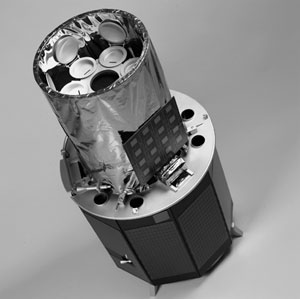 |
|
||
|
|||
Data-gathering
space missions SPIDR satellite will map universe's cosmic web
By Brian Fitzgerald
How do galaxies form, evolve, and cluster with other galaxies? Hoping
to provide answers to these questions, this summer NASA chose the Center
for Space Physics' SPIDR satellite as the next mission in the agency's
Small Explorer (SMEX) program.
|
|
|
|
A model of the SPIDR satellite. Photo courtesy of Draper Lab |
|
"This is a major stepping-stone for us," says Supriya Chakrabarti,
director of the center, a CAS astronomy professor, and the principal investigator
for the $90 million project, which will be launched in 2005. This is the
largest research grant thus far in the University's history.
SPIDR, which stands for spectroscopy and photometry of the intergalactic
medium's diffuse radiation, will map the "cosmic web" of hot
gases that span the universe. Current cosmological theory holds that gases
produced by the Big Bang, which brought the universe into existence, condensed
into a giant filamentary web along which the galaxies and clusters of
galaxies eventually formed. SPIDR's findings will both test this basic
understanding of the nature of the universe and provide new information
to refine this understanding further.
SPIDR is one of two missions chosen by NASA from 46 proposals originally
submitted in February 2000. Chakrabarti says that the SMEX program's preference
for tightly focused, low-cost missions with small to midsized spacecraft
was a major reason that BU received the grant.
"NASA is seeking answers to major, fundamental, profoundquestions,"
he says. "We tried to figure out what was achievable given the available
funds, and we developed a plan that was feasible and low-risk." After
the list was pared down to seven proposals, the researchers wrote a concept
study report, which NASA reviewed. The space agency then sent some 20
experts to spend a day at each institution, scrutinizing different technical,
engineering, and management aspects of its program. Finally, Chakrabarti
and representatives from the six others under consideration traveled to
NASA in late June.
"We were each given 20 minutes to make our case," says Chakrabarti,
"and then, on July 2, NASA announced the selection of its next two
missions." The other mission, to be launched in 2006, is Hampton
University's Aeronomy of Ice in the Mesosphere Explorer, which will determine
the causes of the highest altitude clouds in the earth's atmosphere.
A third of the SPIDR grant will enable BU scientists, who have overall
responsibility for the entire program, to design and build the six innovative
and sensitive ultraviolet spectrographs that will travel on board the
satellite. "Students will be involved in conducting mission and science
operations and performing data analysis," says Chakrabarti.
Roughly one meter wide and two meters long, the satellite will be launched
from the bottom of an airplane flown out of Vandenberg Air Force Base
in California and travel in an elliptical high earth orbit, using spectral
imagery to capture data on gases ranging in temperature from a few hundred
thousand to a million degrees.
The SPIDR project, which includes coinvestigators from eight other universities
and collaborators from Draper Lab in Cambridge, is planned to have a mission
lifetime of at least three years. "About one-third of the funds will
go to Draper to build a 'spacecraft bus,' which is a structure that houses
the electronics and provides pointing control, communicates with the mission
control, and has the necessary computing to carry out all essential tasks,"
says Chakrabarti. "The other third of the funds will go to a private
company, which will launch the satellite."
Members of the Center for Space Physics, including Tim Cook, a CAS research
assistant professor and the satellite mission instrument scientist, and
John Lapington, a research associate and the science payload manager,
will send commands to the satellite in space and gather data that should
answer fundamental questions concerning the formation and evolution of
galaxies, clusters of galaxies, and other large structures in the universe,
as well as address a number of questions related to hot gases in our own
galaxy.
According to the Big Bang theory, the universe started about 16 billion
years ago from an infinitesimally small point with infinitely large mass.
This point violently expanded, creating space, time, and everything else.
Some of this matter coalesced into stars and galaxies, although it is
thought that much of the matter that makes up the universe is unobserved.
"It must have gone somewhere," says Cook. "The question
is: where? Theorists think that the matter heated up and condensed into
these gas filaments." The SPIDR satellite is designed to detect and
measure these gases, which cannot be seen with the naked eye.
SPIDR isn't BU's first satellite - in 1999 the center's TERRIERS satellite
was launched to survey the earth's ionosphere and thermosphere in three
dimensions. However, because of a flaw in the pointing system built by
the center's industry partner, it wasn't able to orient itself so that
its solar panels fully faced the sun, and it ran out of battery power.
Only six SMEX missions have made it into space since 1992, five of which
are still operating and returning data. "From the time Explorer 1
was launched more than 40 years ago and discovered the Van Allen radiation
belts, Explorer satellites have made impressive discoveries by obtaining
significant science at the lowest cost," says Edward Weiler, NASA's
associate administrator for space science. SPIDR "will continue in
the Explorer tradition by investigating some of the most fundamental questions
raised in space science."
![]()
30 August 2002
Boston University
Office of University Relations
